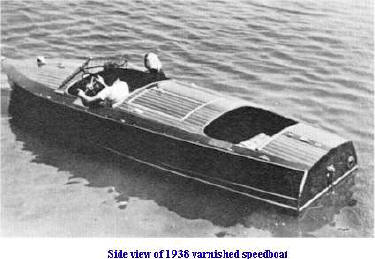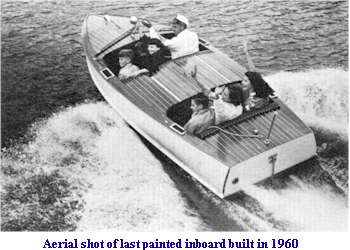by Bob Speltz
Over in the north west corner of Iowa there exists the “Iowa Great Lakes,” consisting of East and West Okoboji, Spirit Lake and other smaller bodies of water which make up one of Iowa’s most popular vacation areas.
 Back in 1896, a man named John Hafer arrived at East Okoboji and began a small boat works that remained until 1968. Mr. Hafer built his first boats in the upstairs of his home! As a boat was completed, she was ‘launched’ out through double windows and down skids to the ground. It was said that many residents of the “Iowa Great Lakes” would have no other boat but a Hafer, be it a launch, sailboat or fishing boat.
Back in 1896, a man named John Hafer arrived at East Okoboji and began a small boat works that remained until 1968. Mr. Hafer built his first boats in the upstairs of his home! As a boat was completed, she was ‘launched’ out through double windows and down skids to the ground. It was said that many residents of the “Iowa Great Lakes” would have no other boat but a Hafer, be it a launch, sailboat or fishing boat.
In 1908, Mr. Hafer built a speedboat that was the fastest in all the midwest for some years. She sped along at a brisk 26 mph – a record that was not to be bettered for quite a time. Mr. Hafer’s young son, Glen, told me the following about the FRANCIS FLYER. She was 40′ long and 6′ wide and took his dad a whole month to build. Back in those days most people felt any boat under 24′ in length was small. The FLYER was powered by a 55 hp, 4 cylinder engine called a Doman. This massive engine tipped the scales at 2,160 pounds, plus it boasted an 8″ bore and 6″ stroke. This particular boat often raced on both Okoboji and Spirit Lakes under the able control of young Glen. His strategy was to let the other boats take off and lead the race and when they were close to the finish line, he would ‘gun’ her and come across the winner. Most of the early boats built by John and Glen Hafer were styled after the Gar Fish, quite long and narrow. Because of their tremendous weight, the early boats could not plane as such and more or less tended to plow through the water.
Glen said his dad built hundreds of 21′ to 24′ family launches. Most of these launches were of the old double-end design, styled somewhat after large excursion boats running at that time on Okoboji and Clear Lakes in Iowa and lakes up in Minnesota. Since they were pointed like a canoe on each end, they were said to have slipped through the water as effortlessly as a “jewel thief at a charity ball!”
As the 1920s moved on, the Hafers turned out larger and more deluxe launches – 24′ to 36′ in length and with engines as large as 40 hp. This continued until about 1927 when Hafer’s customers began to prefer a new type of boat – the runabout. By this time, Glen had been working full time for his Dad for about two years. They started experimenting and building some all-mahogany speedboats of various lengths and horsepower. From 1932 through 1939 they built some beautiful 17′ and 19′ all varnished speedboats. Several of these were powered by converted Mercury car engines. (See photo #I). These boats were all hand built and would rival anything turned out by the major builders of the era.  The Hafers also built hundreds of smooth-sided fishing boats, outboard runabouts, and sail boats in their little plant. During the peak building periods in the winter, they employed an average of seven men. Glen spent the years 1925 through 1944 racing Hafer Craft boats on the midwest circuit. Glen once told me that back in the ’20s you could take a trip around the lakes and see nothing but Hafer launches, row boats, and outboards. Following World War II, in 1943, Glen started building small 14′ inboard speedboats powered by 45 hp Gray engines. He was a pioneer in this field and to this day, a number of these little gems can be seen ‘zipping’ around the lake daily. Later, as interest in inboards increased, boats were lengthened to 16′ and powered by 90 hp Grays. From 1946 through 1960, the Hafer Craft inboard was offered to the public in three exciting models. The following information was taken from the 1960 Water Boat Literature:
The Hafers also built hundreds of smooth-sided fishing boats, outboard runabouts, and sail boats in their little plant. During the peak building periods in the winter, they employed an average of seven men. Glen spent the years 1925 through 1944 racing Hafer Craft boats on the midwest circuit. Glen once told me that back in the ’20s you could take a trip around the lakes and see nothing but Hafer launches, row boats, and outboards. Following World War II, in 1943, Glen started building small 14′ inboard speedboats powered by 45 hp Gray engines. He was a pioneer in this field and to this day, a number of these little gems can be seen ‘zipping’ around the lake daily. Later, as interest in inboards increased, boats were lengthened to 16′ and powered by 90 hp Grays. From 1946 through 1960, the Hafer Craft inboard was offered to the public in three exciting models. The following information was taken from the 1960 Water Boat Literature:
“Hafer offers three great inboard cruisers.
1 – FIREBALL 90 – With its gleaming mahogany deck, perfect crafting, luxurious upholstery and mighty Gray Marine Fire Ball 90, makes you the envy of the lake!
2 – UTILITY – The economy priced UTILITY offers some features found in more plush models, but powered by a 75 hp Gray.
3 – PHANTOM 75 – Another split-cockpit runabout with engine mounted amidships to balance the boat for optimum performance!”
As I mentioned earlier, these three models were produced until 1960 when all new boat construction ceased as larger boat builders and fiberglass took over the bulk of the new boat market. For the next eight years, Glen and the crew busied themselves operating a 40 boat marina as well as selling boats, boating supplies and offering expert repair and refinishing service.
My twin brother, Art, and I visited with Mr. Hafer back in August of 1961. His neat little marina is built on top of a small hill from which he could keep a ‘weather eye’ on all operations. There were about a dozen Hafer Crafts, two ancient Chris Crafts plus a Century or two moored there. I shot some colored slides that trip which I now value highly. Last summer I stopped again after ten years and found it hard to believe my own eyes! The whole marina was rundown, full of weeds with the docks all awry. Later I learned that Glen had sold out some years ago.
In our last conversation, Glen relayed a story I felt too good to leave out. Years ago, the old amusement park over on West Okoboji had many speedboats and launches used to carry passengers. His firm built many of these boats, one of which was the 27′ EAGLE 1, powered by a 250 hp Sterling engine that ran daily from 1920 through 1937. Other boats of that era included the TEASER, powered by a 450 hp Liberty engine and the fastest boat on the lake, the MISS THRILLER, a 28′ Sea Sled powered by two 300 hp Fiat engines! An interesting sidelight about MISS THRILLER, was that she ended her career on the bottom of Lake Okoboji. One hot summer night she collided with a slower Hafer built speedboat named ZIPPER, and nine people lost their lives. Many law suits resulted from the accident and the Iowa Conservation Commission put a 15 mph speed limit on all Iowa Lakes that lasted for some years. In closing, I hope you enjoyed reading this report as much as I did preparing it. I like to research the small lesser-known Midwest boats and builders. Any comments, additions or corrections you would care to send me would be most welcome. I want to thank my good friend, Glen Hafer, for providing me with most of this material as well as the fine photos. Glen, this is a tribute to a real master boat builder that I have been fortunate to know.

